Abstract
The effects of lovastatin therapy on the parameters of body cholesterol metabolism were explored in nine hypercholesterolemic patients. Long-term cholesterol turnover studies were performed before therapy, and were repeated after 15 mo of lovastatin therapy (40 mg/d) while continuing on therapy. The major question addressed was whether a reduction in plasma cholesterol level with lovastatin would be associated with a reduction in the whole-body production rate of cholesterol or with the sizes of exchangeable body cholesterol pools as determined by the three-pool model of cholesterol turnover. The mean plasma cholesterol level decreased 19.4% (from 294 to 237 mg/dl), and low-density lipoprotein cholesterol decreased 23.8% (from 210 to 159 mg/dl) with lovastatin therapy. Changes in high-density lipoprotein cholesterol level were not significant. The cholesterol production rate did not change significantly with therapy (1.09 +/- 0.10 [mean +/- S.D.] vs. 1.17 +/- 0.09 g/d). By comparison, colestipol and niacin treatment in three other subjects more than doubled the cholesterol production rate (1.14 +/- 0.28 vs. 2.42 +/- 0.34 g/d). Thus, hydroxymethylglutaryl-coenzyme A (HMG-CoA) reductase inhibition by lovastatin at the therapeutic dose used here did not change the steady-state rate of whole-body cholesterol synthesis. Despite the changes in plasma cholesterol levels, no significant changes were seen in the values of M1, of M3 or of Mtot, the sizes of the pools of rapidly, of slowly, and of total body exchangeable cholesterol. Conclusion: lovastatin therapy to lower plasma cholesterol does not lead to corresponding reductions in body cholesterol pools or to a reduction in the rate of whole-body cholesterol synthesis. In the new steady state that exists during long-term lovastatin therapy, along with increased expression of the genes for HMG-CoA reductase and the LDL receptor, the body compensates for the effects of the drug so that cholesterol production rate and tissue pool sizes are not changed from pretreatment values.
Full text
PDF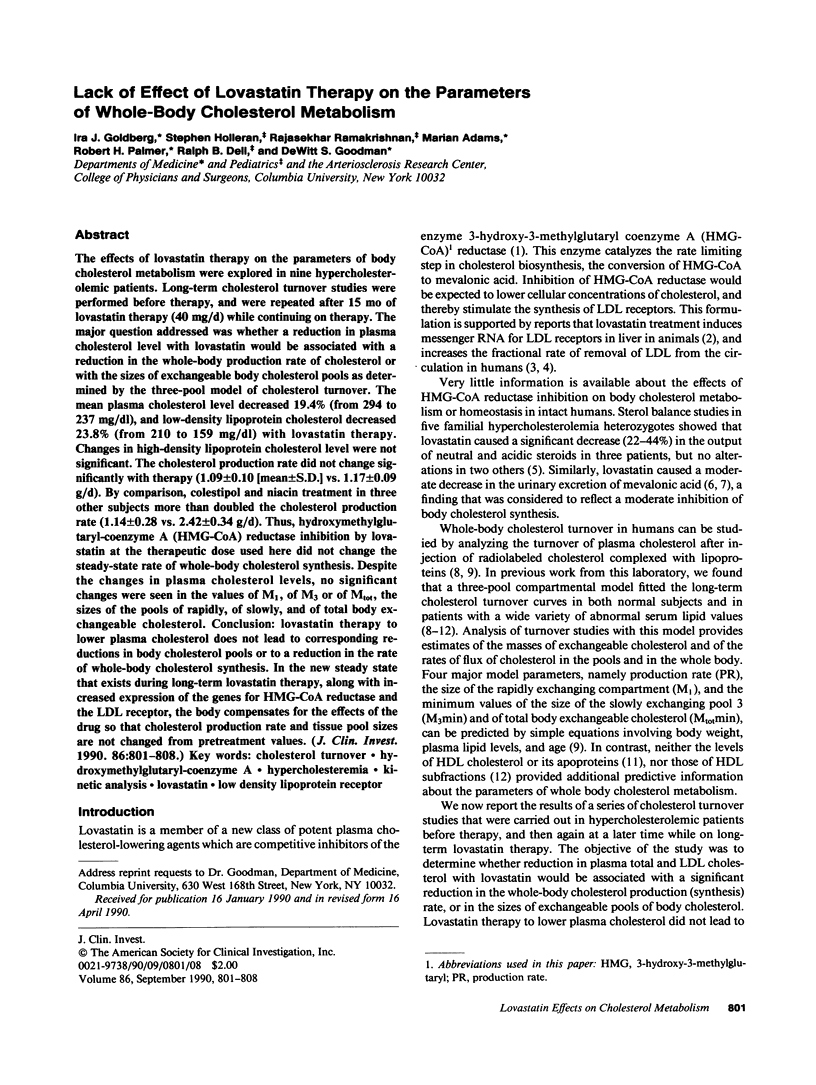
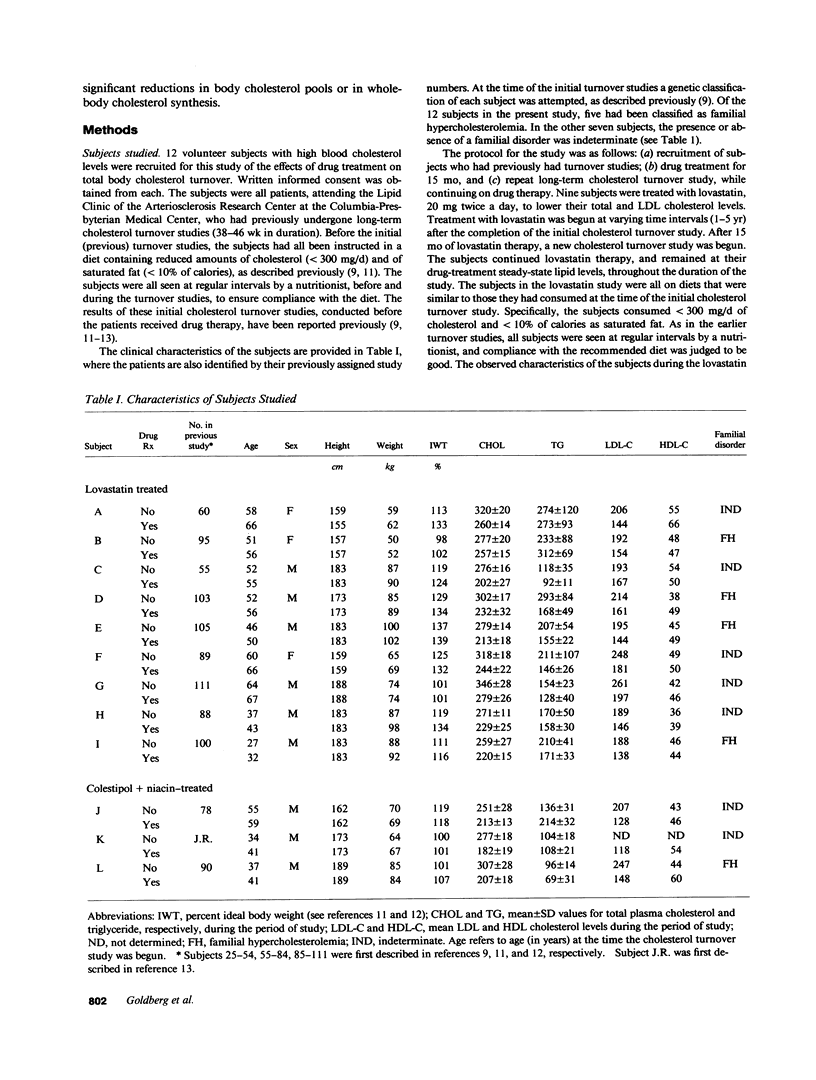
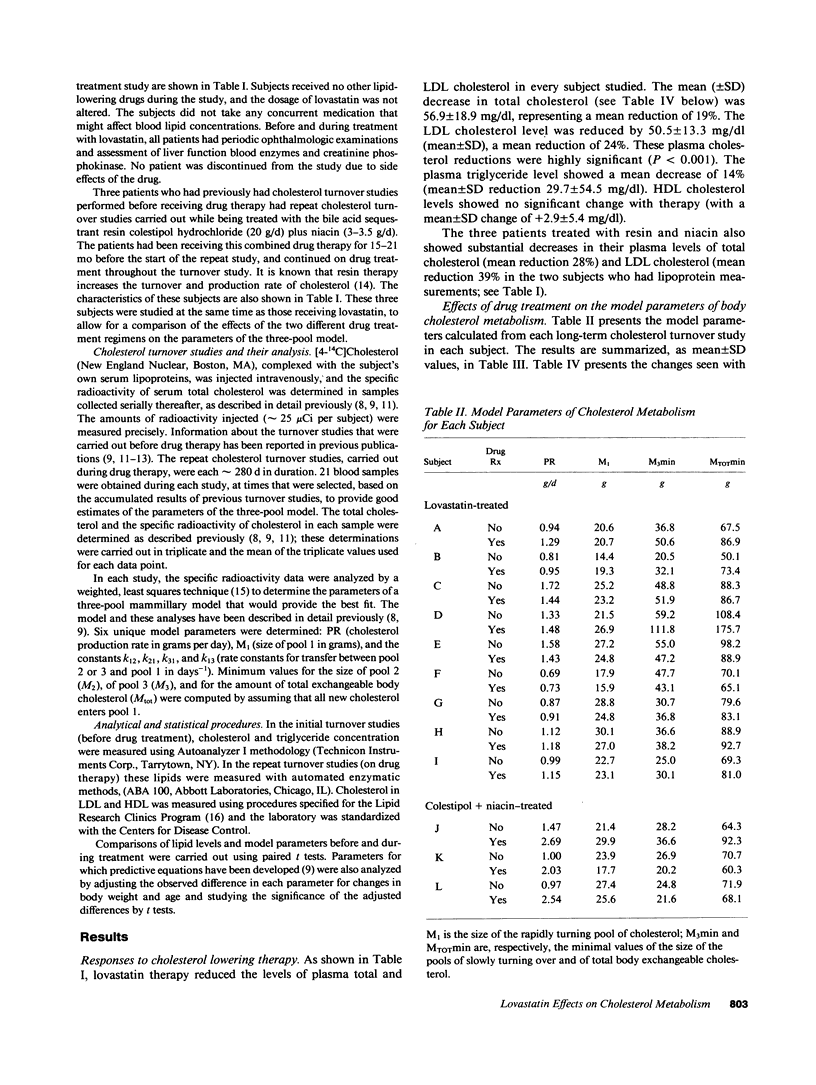
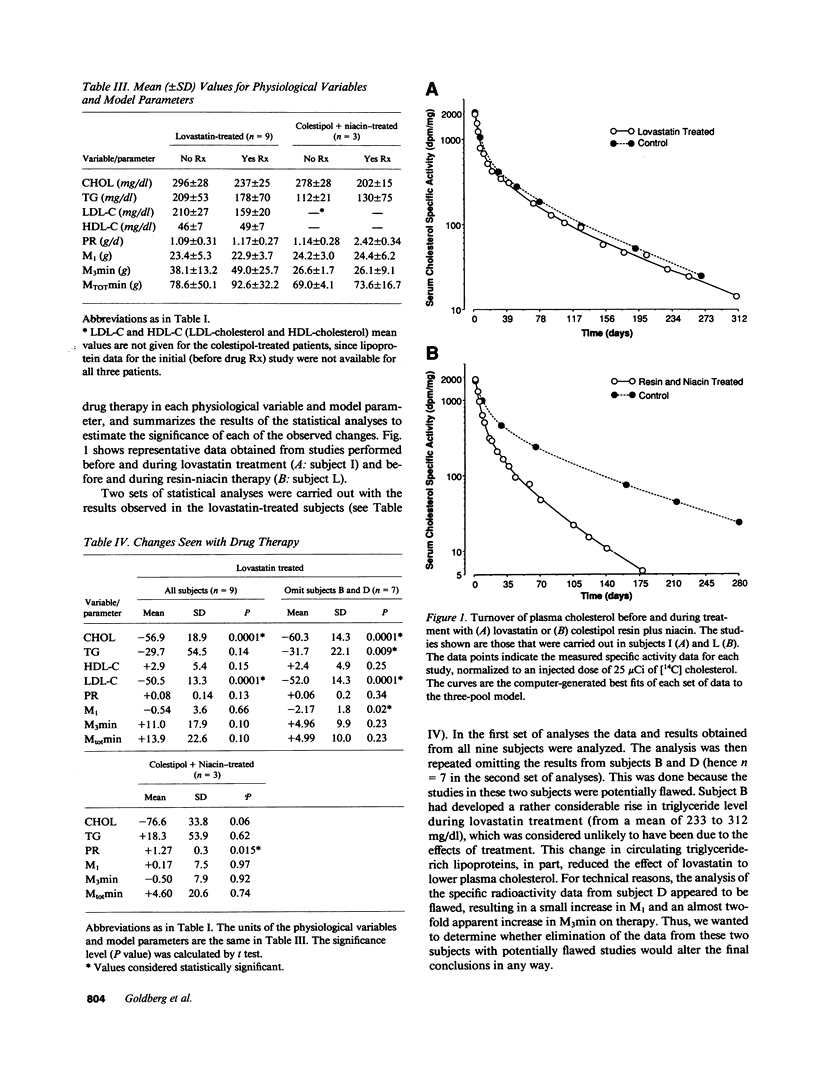

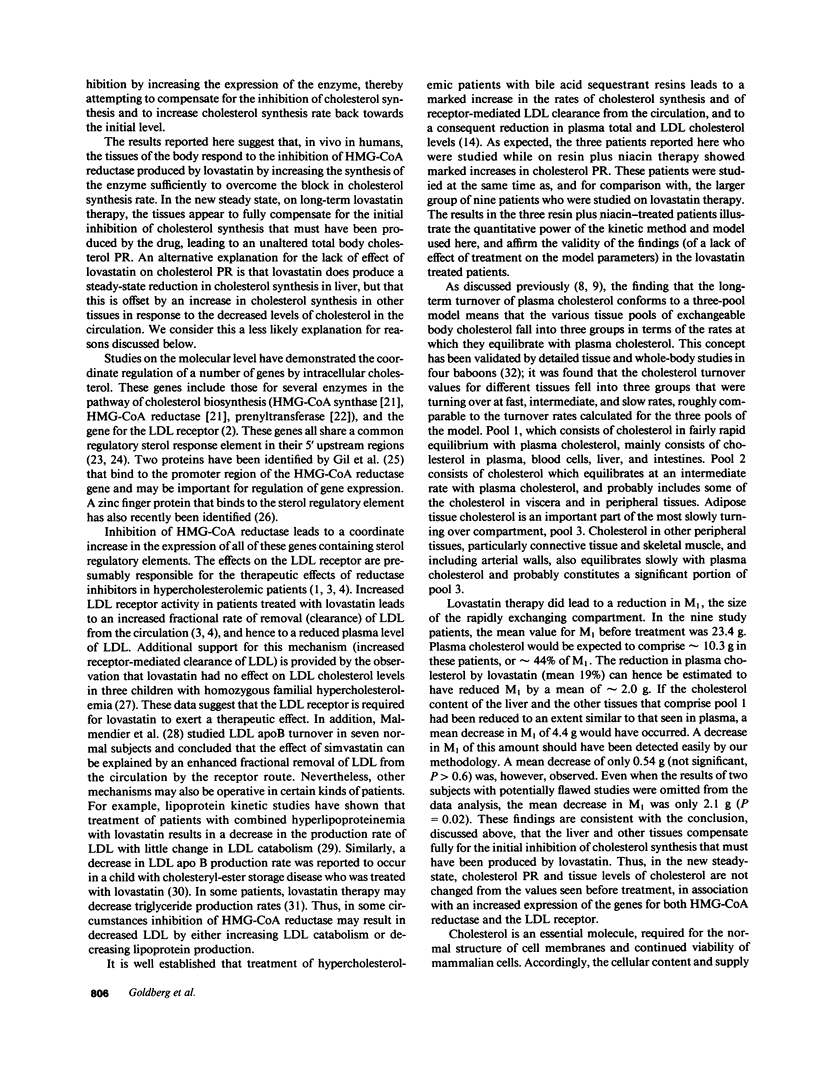
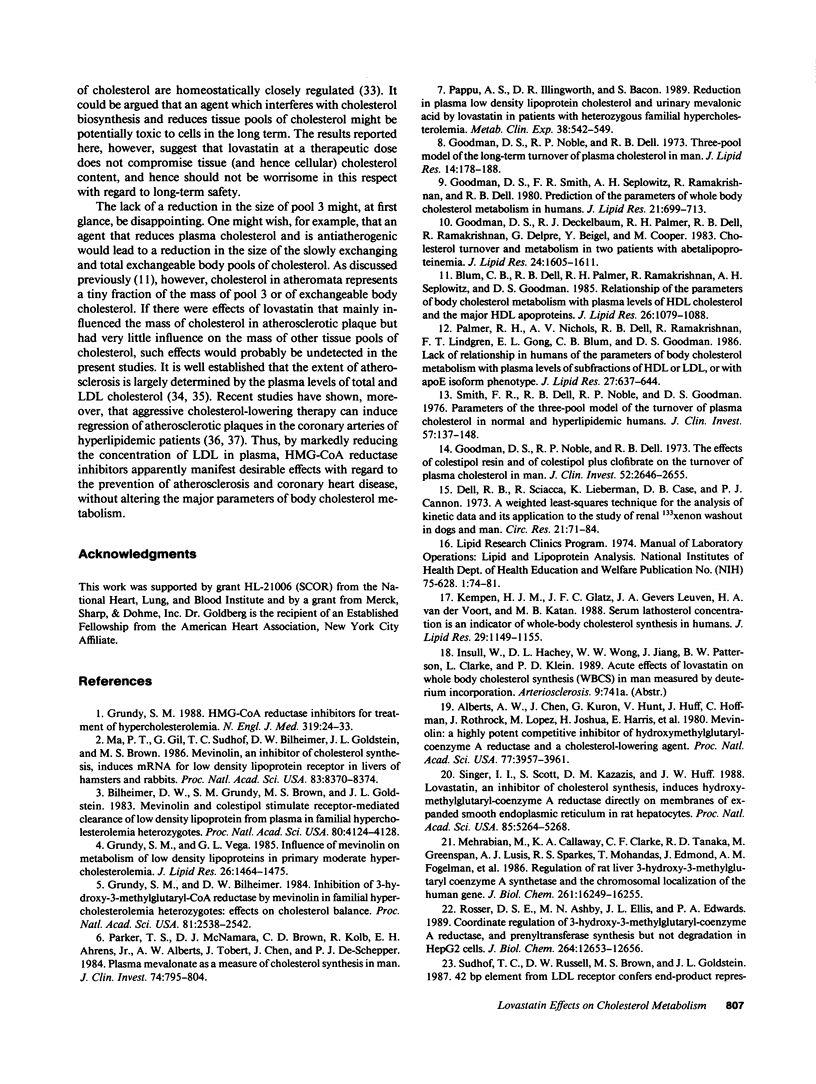

Selected References
These references are in PubMed. This may not be the complete list of references from this article.
- Alberts A. W., Chen J., Kuron G., Hunt V., Huff J., Hoffman C., Rothrock J., Lopez M., Joshua H., Harris E. Mevinolin: a highly potent competitive inhibitor of hydroxymethylglutaryl-coenzyme A reductase and a cholesterol-lowering agent. Proc Natl Acad Sci U S A. 1980 Jul;77(7):3957–3961. doi: 10.1073/pnas.77.7.3957. [DOI] [PMC free article] [PubMed] [Google Scholar]
- Arad Y., Ramakrishnan R., Ginsberg H. N. Lovastatin therapy reduces low density lipoprotein apoB levels in subjects with combined hyperlipidemia by reducing the production of apoB-containing lipoproteins: implications for the pathophysiology of apoB production. J Lipid Res. 1990 Apr;31(4):567–582. [PubMed] [Google Scholar]
- Bilheimer D. W., Grundy S. M., Brown M. S., Goldstein J. L. Mevinolin and colestipol stimulate receptor-mediated clearance of low density lipoprotein from plasma in familial hypercholesterolemia heterozygotes. Proc Natl Acad Sci U S A. 1983 Jul;80(13):4124–4128. doi: 10.1073/pnas.80.13.4124. [DOI] [PMC free article] [PubMed] [Google Scholar]
- Blankenhorn D. H., Nessim S. A., Johnson R. L., Sanmarco M. E., Azen S. P., Cashin-Hemphill L. Beneficial effects of combined colestipol-niacin therapy on coronary atherosclerosis and coronary venous bypass grafts. JAMA. 1987 Jun 19;257(23):3233–3240. [PubMed] [Google Scholar]
- Blum C. B., Dell R. B., Palmer R. H., Ramakrishnan R., Seplowitz A. H., Goodman D. S. Relationship of the parameters of body cholesterol metabolism with plasma levels of HDL cholesterol and the major HDL apoproteins. J Lipid Res. 1985 Sep;26(9):1079–1088. [PubMed] [Google Scholar]
- Brown M. S., Goldstein J. L. A receptor-mediated pathway for cholesterol homeostasis. Science. 1986 Apr 4;232(4746):34–47. doi: 10.1126/science.3513311. [DOI] [PubMed] [Google Scholar]
- Dell R. B., Mott G. E., Jackson E. M., Ramakrishnan R., Carey K. D., McGill H. C., Jr, Goodman D. S. Whole body and tissue cholesterol turnover in the baboon. J Lipid Res. 1985 Mar;26(3):327–337. [PubMed] [Google Scholar]
- Dell R. B., Sciacca R., Lieberman K., Case D. B., Cannon P. J. A weighted least-squares technique for the analysis of kinetic data and its application to the study of renal xenon washout in dogs and man. Circ Res. 1973 Jan;32(1):71–84. doi: 10.1161/01.res.32.1.71. [DOI] [PubMed] [Google Scholar]
- Feinleib M., Kannel W. B., Tedeschi C. G., Landau T. K., Garrison R. J. The relation of antemortem characteristics to cardiovascular findings at necropsy--The Framingham Study. Atherosclerosis. 1979 Oct;34(2):145–157. doi: 10.1016/0021-9150(79)90136-9. [DOI] [PubMed] [Google Scholar]
- Gil G., Osborne T. F., Goldstein J. L., Brown M. S. Purification of a protein doublet that binds to six TGG-containing sequences in the promoter for hamster 3-hydroxy-3-methylglutaryl-coenzyme A reductase. J Biol Chem. 1988 Dec 15;263(35):19009–19019. [PubMed] [Google Scholar]
- Ginsberg H. N., Le N. A., Short M. P., Ramakrishnan R., Desnick R. J. Suppression of apolipoprotein B production during treatment of cholesteryl ester storage disease with lovastatin. Implications for regulation of apolipoprotein B synthesis. J Clin Invest. 1987 Dec;80(6):1692–1697. doi: 10.1172/JCI113259. [DOI] [PMC free article] [PubMed] [Google Scholar]
- Goodman D. S., Deckelbaum R. J., Palmer R. H., Dell R. B., Ramakrishnan R., Delpre G., Beigel Y., Cooper M. Cholesterol turnover and metabolism in two patients with abetalipoproteinemia. J Lipid Res. 1983 Dec;24(12):1605–1611. [PubMed] [Google Scholar]
- Goodman D. S., Noble R. P., Dell R. B. The effects of colestipol resin and of colestipol plus clofibrate on the turnover of plasma cholesterol in man. J Clin Invest. 1973 Oct;52(10):2646–2655. doi: 10.1172/JCI107457. [DOI] [PMC free article] [PubMed] [Google Scholar]
- Goodman D. S., Noble R. P., Dell R. B. Three-pool model of the long-term turnover of plasma cholesterol in man. J Lipid Res. 1973 Mar;14(2):178–188. [PubMed] [Google Scholar]
- Goodman D. S., Smith F. R., Seplowitz A. H., Ramakrishnan R., Dell R. B. Prediction of the parameters of whole body cholesterol metabolism in humans. J Lipid Res. 1980 Aug;21(6):699–713. [PubMed] [Google Scholar]
- Grundy S. M., Bilheimer D. W. Inhibition of 3-hydroxy-3-methylglutaryl-CoA reductase by mevinolin in familial hypercholesterolemia heterozygotes: effects on cholesterol balance. Proc Natl Acad Sci U S A. 1984 Apr;81(8):2538–2542. doi: 10.1073/pnas.81.8.2538. [DOI] [PMC free article] [PubMed] [Google Scholar]
- Grundy S. M. HMG-CoA reductase inhibitors for treatment of hypercholesterolemia. N Engl J Med. 1988 Jul 7;319(1):24–33. doi: 10.1056/NEJM198807073190105. [DOI] [PubMed] [Google Scholar]
- Grundy S. M., Vega G. L. Influence of mevinolin on metabolism of low density lipoproteins in primary moderate hypercholesterolemia. J Lipid Res. 1985 Dec;26(12):1464–1475. [PubMed] [Google Scholar]
- Kempen H. J., Glatz J. F., Gevers Leuven J. A., van der Voort H. A., Katan M. B. Serum lathosterol concentration is an indicator of whole-body cholesterol synthesis in humans. J Lipid Res. 1988 Sep;29(9):1149–1155. [PubMed] [Google Scholar]
- Ma P. T., Gil G., Südhof T. C., Bilheimer D. W., Goldstein J. L., Brown M. S. Mevinolin, an inhibitor of cholesterol synthesis, induces mRNA for low density lipoprotein receptor in livers of hamsters and rabbits. Proc Natl Acad Sci U S A. 1986 Nov;83(21):8370–8374. doi: 10.1073/pnas.83.21.8370. [DOI] [PMC free article] [PubMed] [Google Scholar]
- Malmendier C. L., Lontie J. F., Delcroix C., Magot T. Effect of simvastatin on receptor-dependent low density lipoprotein catabolism in normocholesterolemic human volunteers. Atherosclerosis. 1989 Dec;80(2):101–109. doi: 10.1016/0021-9150(89)90017-8. [DOI] [PubMed] [Google Scholar]
- Mehrabian M., Callaway K. A., Clarke C. F., Tanaka R. D., Greenspan M., Lusis A. J., Sparkes R. S., Mohandas T., Edmond J., Fogelman A. M. Regulation of rat liver 3-hydroxy-3-methylglutaryl coenzyme A synthase and the chromosomal localization of the human gene. J Biol Chem. 1986 Dec 5;261(34):16249–16255. [PubMed] [Google Scholar]
- Osborne T. F., Goldstein J. L., Brown M. S. 5' end of HMG CoA reductase gene contains sequences responsible for cholesterol-mediated inhibition of transcription. Cell. 1985 Aug;42(1):203–212. doi: 10.1016/s0092-8674(85)80116-1. [DOI] [PubMed] [Google Scholar]
- Palmer R. H., Nichols A. V., Dell R. B., Ramakrishnan R., Lindgren F. T., Gong E. L., Blum C. B., Goodman D. S. Lack of relationship in humans of the parameters of body cholesterol metabolism with plasma levels of subfractions of HDL or LDL, or with apoE isoform phenotype. J Lipid Res. 1986 Jun;27(6):637–644. [PubMed] [Google Scholar]
- Pappu A. S., Illingworth D. R., Bacon S. Reduction in plasma low-density lipoprotein cholesterol and urinary mevalonic acid by lovastatin in patients with heterozygous familial hypercholesterolemia. Metabolism. 1989 Jun;38(6):542–549. doi: 10.1016/0026-0495(89)90214-x. [DOI] [PubMed] [Google Scholar]
- Parker T. S., McNamara D. J., Brown C. D., Kolb R., Ahrens E. H., Jr, Alberts A. W., Tobert J., Chen J., De Schepper P. J. Plasma mevalonate as a measure of cholesterol synthesis in man. J Clin Invest. 1984 Sep;74(3):795–804. doi: 10.1172/JCI111495. [DOI] [PMC free article] [PubMed] [Google Scholar]
- Rajavashisth T. B., Taylor A. K., Andalibi A., Svenson K. L., Lusis A. J. Identification of a zinc finger protein that binds to the sterol regulatory element. Science. 1989 Aug 11;245(4918):640–643. doi: 10.1126/science.2562787. [DOI] [PubMed] [Google Scholar]
- Reed D. M., MacLean C. J., Hayashi T. Predictors of atherosclerosis in the Honolulu Heart Program. I. Biologic, dietary, and lifestyle characteristics. Am J Epidemiol. 1987 Aug;126(2):214–225. doi: 10.1093/aje/126.2.214. [DOI] [PubMed] [Google Scholar]
- Rosser D. S., Ashby M. N., Ellis J. L., Edwards P. A. Coordinate regulation of 3-hydroxy-3-methylglutaryl-coenzyme A synthase, 3-hydroxy-3-methylglutaryl-coenzyme A reductase, and prenyltransferase synthesis but not degradation in HepG2 cells. J Biol Chem. 1989 Jul 25;264(21):12653–12656. [PubMed] [Google Scholar]
- Singer I. I., Scott S., Kazazis D. M., Huff J. W. Lovastatin, an inhibitor of cholesterol synthesis, induces hydroxymethylglutaryl-coenzyme A reductase directly on membranes of expanded smooth endoplasmic reticulum in rat hepatocytes. Proc Natl Acad Sci U S A. 1988 Jul;85(14):5264–5268. doi: 10.1073/pnas.85.14.5264. [DOI] [PMC free article] [PubMed] [Google Scholar]
- Smith F. R., Dell R. B., Noble R. P., Goodman D. S. Parameters of the three-pool model of the turnover of plasma cholesterol in normal and hyperlipidemic humans. J Clin Invest. 1976 Jan;57(1):137–148. doi: 10.1172/JCI108253. [DOI] [PMC free article] [PubMed] [Google Scholar]
- Südhof T. C., Russell D. W., Brown M. S., Goldstein J. L. 42 bp element from LDL receptor gene confers end-product repression by sterols when inserted into viral TK promoter. Cell. 1987 Mar 27;48(6):1061–1069. doi: 10.1016/0092-8674(87)90713-6. [DOI] [PubMed] [Google Scholar]
- Uauy R., Vega G. L., Grundy S. M., Bilheimer D. M. Lovastatin therapy in receptor-negative homozygous familial hypercholesterolemia: lack of effect on low-density lipoprotein concentrations or turnover. J Pediatr. 1988 Aug;113(2):387–392. doi: 10.1016/s0022-3476(88)80289-0. [DOI] [PubMed] [Google Scholar]


